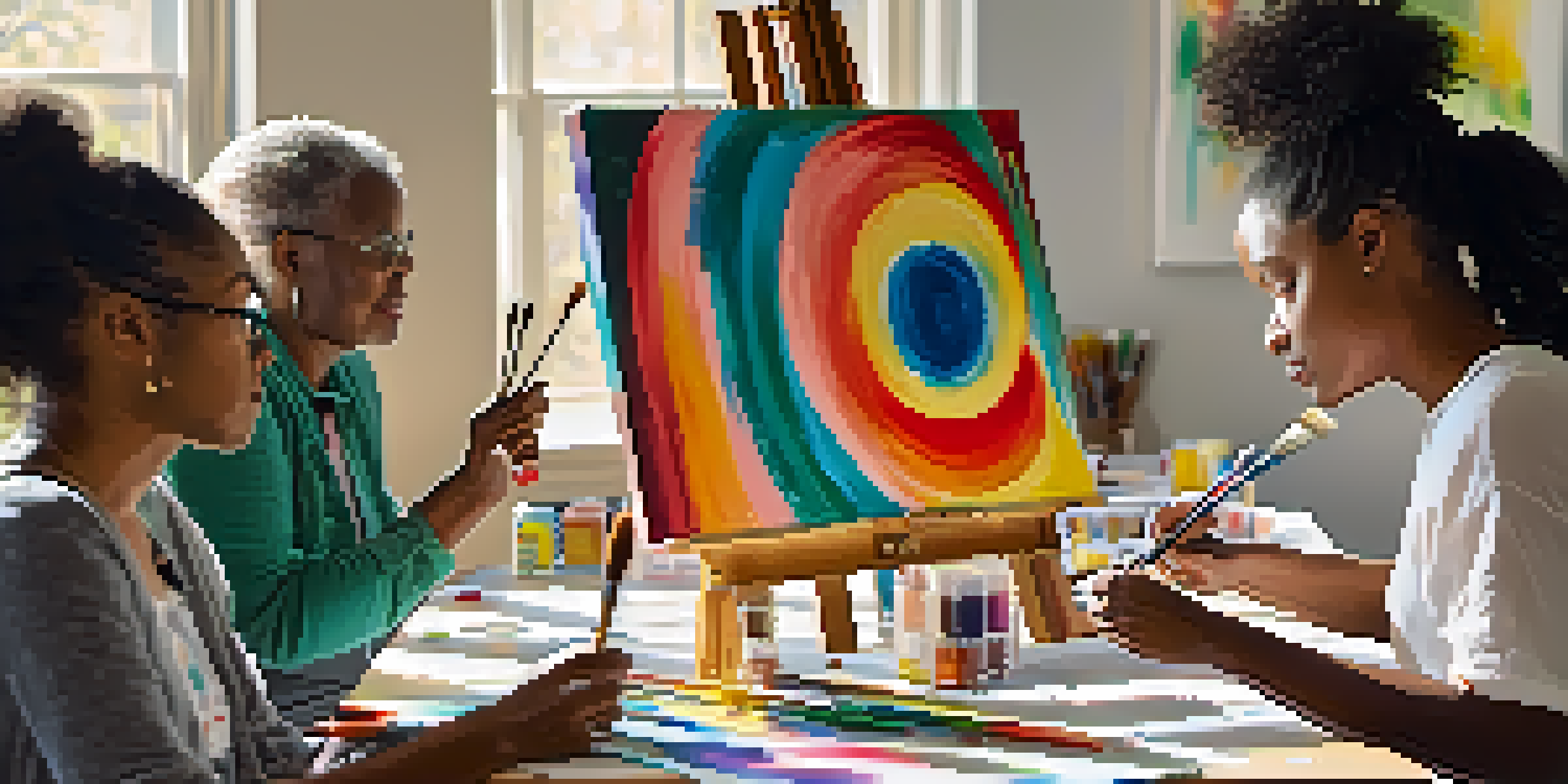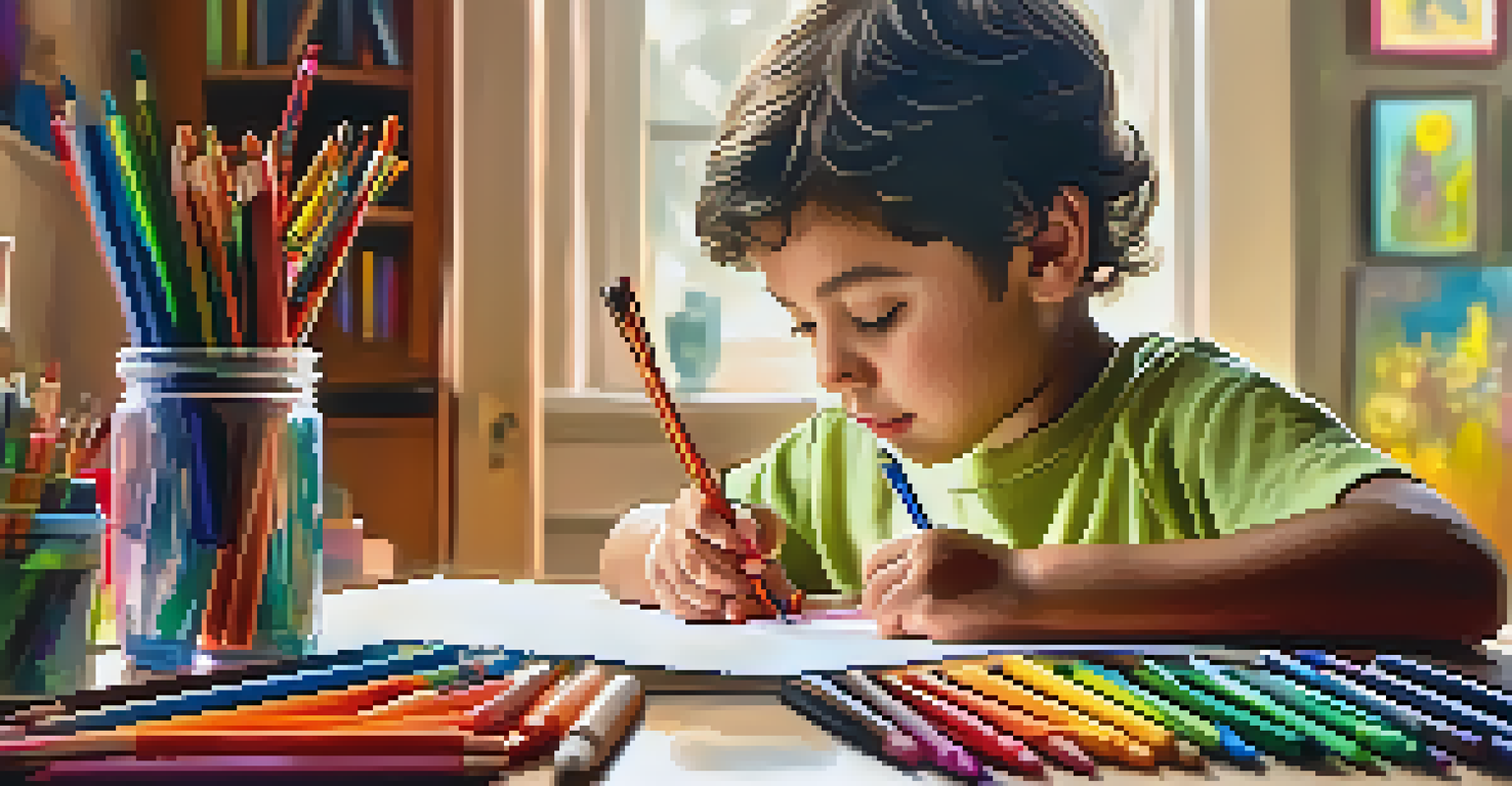Art Therapy: Healing Through Creative Expression

Understanding Art Therapy and Its Benefits
Art therapy combines the creative process of making art with therapeutic techniques to improve mental health. It's not about creating a masterpiece; it's about expression and exploration. This form of therapy can help individuals communicate feelings they might struggle to verbalize, making it particularly beneficial for children and those with trauma.
Art is not what you see, but what you make others see.
Through various mediums like painting, drawing, or sculpture, participants can tap into their emotions and thoughts in a safe space. This process can lead to insights and breakthroughs that traditional talk therapy might not achieve. The therapeutic benefits are vast, including reduced anxiety, improved mood, and enhanced self-esteem.
Ultimately, art therapy serves as a bridge between the subconscious and conscious mind, allowing for healing through creativity. It’s a gentle and non-invasive way for people to explore their inner worlds and find peace.
The Science Behind Art Therapy's Healing Power
Research has shown that engaging in creative activities can stimulate brain regions associated with emotion regulation and stress relief. When individuals create art, they often experience a release of endorphins, the body's natural feel-good chemicals. This biological response can lead to a decrease in symptoms of anxiety and depression.

Moreover, art therapy promotes mindfulness, encouraging individuals to focus on the process rather than the end product. This mindfulness aspect can help distract from negative thoughts and foster a sense of calm. Just like yoga or meditation, art can ground individuals in the moment, making it a powerful tool for emotional regulation.
Art Therapy Enhances Emotional Expression
Art therapy helps individuals communicate complex feelings through creative processes, making it especially beneficial for those who struggle with verbal expression.
By understanding the science behind art therapy, we can appreciate its role in holistic healing. It's not just about making pretty pictures; it's about engaging the mind and body in a way that nurtures overall well-being.
Who Can Benefit from Art Therapy?
Art therapy is versatile and can benefit a wide range of individuals, including those dealing with mental health issues, chronic illness, or trauma. It can be particularly effective for children, who often find it easier to express themselves through art than through words. This makes it a valuable tool in schools and therapeutic settings.
Creativity takes courage.
Adults facing stress, depression, or anxiety can also find solace in art therapy. The creative process provides an opportunity for self-reflection and can help in coping with life's challenges. It's a safe outlet for emotions that might otherwise feel overwhelming.
Even those without prior artistic experience can thrive in art therapy. The focus is on the process of creation rather than artistic skill, allowing everyone to explore their creativity and express their feelings authentically.
The Role of the Art Therapist
An art therapist is a trained professional who guides individuals through the creative process while providing a supportive environment. They are skilled in both art and psychology, allowing them to understand the emotional significance of the artwork created. This dual expertise helps them interpret and facilitate healing through art.
During sessions, the therapist may introduce specific themes or techniques to explore. However, they also allow clients the freedom to express themselves as they see fit. This balance of guidance and autonomy is critical in helping individuals feel safe and empowered to share their stories.
Science Supports Art Therapy's Benefits
Research indicates that engaging in art can stimulate brain regions related to emotion regulation, leading to reduced anxiety and improved mood.
Ultimately, the art therapist acts as a compassionate facilitator, helping individuals navigate their emotional landscapes while fostering self-discovery and healing through creativity.
Techniques Used in Art Therapy
Art therapy encompasses a variety of techniques, each tailored to meet the needs of the individual. Some common methods include drawing, painting, collage-making, and even digital art. Each medium offers unique opportunities for expression and can resonate differently with participants.
For instance, drawing can help individuals visualize their feelings, while painting might allow for a more abstract representation of emotions. Collage-making, on the other hand, can be a powerful way to create a narrative or story from different elements. The choice of medium can enhance the therapeutic experience and lead to deeper insights.
These techniques are often combined with other therapeutic practices, such as cognitive-behavioral approaches, to maximize their effectiveness. The flexibility in methods ensures that art therapy can be tailored to suit individual preferences and therapeutic goals.
Real-Life Success Stories in Art Therapy
Many individuals have found transformative healing through art therapy. For example, a young girl who struggled with anxiety learned to express her fears through painting, ultimately depicting her feelings in vibrant colors. This not only provided her relief but also helped her articulate her emotions to her therapist and family.
Another inspiring case is that of a veteran coping with PTSD. Through art therapy, he created a mural that reflected his experiences and emotions, allowing him to process his trauma in a supportive environment. This not only aided in his healing journey but also fostered a sense of community and understanding among peers.
Accessible for All Ages and Skills
Art therapy is versatile and can benefit anyone, regardless of artistic skill, by focusing on the creative process rather than the final product.
These stories highlight the profound impact art therapy can have on individuals’ lives, showcasing its ability to facilitate healing and self-discovery through creative expression.
How to Get Started with Art Therapy
If you're interested in exploring art therapy, the first step is to research qualified art therapists in your area. Many therapists offer introductory sessions to help you understand the process and what to expect. It’s essential to find someone who resonates with you and your needs.
You can also engage in art-making at home, whether through guided online sessions or simply experimenting with materials on your own. The goal is to create without judgment, allowing your creativity to flow freely. Journaling about your experiences can further enhance the therapeutic benefits.

Remember, art therapy is about personal expression and healing, so there are no right or wrong ways to engage with it. Embrace the journey, and you may be surprised at the insights and relief you discover along the way.